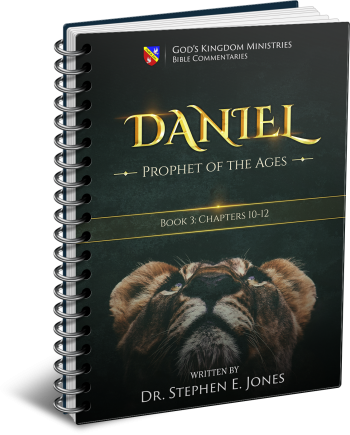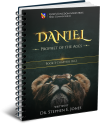Latest Posts
View the latest posts in an easy-to-read list format, with filtering options.

This is a commentary covering the last three of Daniel's visions in chapters 10-12.
Category - Bible Commentaries

We have seen how the time of distress, or tribulation, has occurred more than once in past history, each with its own manifestation of antichrist along with a betrayer.
There have been other patterns as well that are incomplete, but yet they add prophetic details to the prophecy of antichrist. For example, Adonijah was an antichrist who attempted to usurp the throne of David from Solomon, the anointed one. He received help from the high priest Abiathar, who betrayed his friend David in this matter (1 Kings 1:7).
Of course, the great tribulation has taken place over a period of “seven times,” or 7 x 360 years. In this manifestation, God called Nebuchadnezzar (Jer. 27:6) to destroy Jerusalem and the temple which had already been desecrated by the priests. Like Onias and Caiaphas in later times, the priests in Jeremiah’s day had turned the temple into “a den of robbers” (Jer. 7:11; Matt. 21:13).
Which is worse, turning the temple into a shrine to Jupiter, or making it a robbers’ den? In either case, the priests usurped the temple for their own carnal use. Since the temple was where the glory of God (Christ) resided, these priests made themselves antichrist, and the glory departed (Ezekiel 10:18; 11:23). These antichrists were assisted by the false prophets, particularly Hananiah (Jer. 28:15).
We know from the book of Daniel that the king of Babylon was only the first of four beast empires that were to bring this long tribulation. The time of tribulation ends in 2014-2017, as I explained earlier. In a sense, then, the tribulation of Antiochus in Daniel 11 serves as a short-term pattern of the long-term tribulation that began in the time of Jeremiah.
The fact that the short-term tribulation of Antiochus was a pattern for the long-term tribulation of the beast nations provides the continuity of the angel’s prophecy. Otherwise, there is a long gap between Antiochus and the resurrection of the dead. The angel is therefore able to skip over many centuries of history, leaving the prophecies of the fourth beast to John, the Revelator.
Of course, the longest fulfillment of this tribulation began as the result of Adam’s sin, which desecrated the earth, preventing it from being filled with the glory of God. This drove a wedge between heaven and earth, postponing their unity until the time of the end. The whole creation came into bondage to corruption (Rom. 8:19-21).
According to the law in Exodus 21:2, creation was sold into slavery for six years, or in this case, 6,000 years. The law then provided for a release during the seventh millennium. We are now at the end of that time of slavery, and for this reason God is about to give rest to the earth and release the nations from the tyranny of the beast nations.
Paul says that creation is anxiously awaiting the manifestation of the Sons of God. From other Scriptures, we know that this event is accompanied by the resurrection. So also, Daniel speaks of the resurrection at the end of the tribulation. Dan. 12:2, 3 says,
2 And many of those who sleep in the dust of the ground will awake, these to everlasting [olam] life, but the others to disgrace [cherpah, “reproach, rebuke”] and everlasting [olam] contempt [deraown, “aversion, abhorrence,”]. 3 And those who have insight [sakal, “to see, understand, be wise”] will shine brightly like the brightness of the expanse of heaven, and those who lead the many to righteousness, like the stars forever and ever.
First, those being resurrected are sleeping in the dust of the ground. The metaphor links death to the statement in Gen. 2:7, where “the Lord God formed man of dust from the ground.” When man sinned, he died (became mortal) and eventually returned to his original state, as Gen. 3:19 says, “For you are dust, and to dust you shall return.”
The temporary state of death is seen by the metaphor of “sleep” that ends with an awakening—literally, “an arousal.” But the angel tells Daniel that some will awaken to disgrace, while others will return in a glorified body.
The condition of each is said to be olam, which the NASB mistranslates “everlasting.” The Hebrew word refers to an indefinite (hidden) period of time, not an infinite period of time. The word olam comes from the root word alam, which means “to conceal, to hide.”
Olam, when applied to time, refers to a hidden, secret, unknown, or indefinite period of time. So we find that Scripture uses the term to describe the three days that Jonah was in the belly of the whale (Jonah 2:6), “the earth with its bars was around me OLAM, but Thou hast brought up my life from the pit, O Lord my God.” If Jonah was to be brought up from the pit, then how could he remain in the belly of the whale forever?
Likewise, the Old Covenant was said to be “an OLAM covenant” (Lev. 24:8). That covenant did not last forever, because it was inadequate. No one could keep it, because “all have sinned” (Rom. 3:23). So Heb. 8:13 says it “is becoming obsolete and growing old is ready to disappear.” It was never intended to be an everlasting covenant. In the time of Moses, however, no one knew how long that covenant would last. The time was unknown and hidden from them. Therefore, its effectiveness was olam, “indefinite,” but not “forever.”
Again, when Phinehas, the son of Eleazar, the son of Aaron, distinguished himself, he was promised “a perpetual [olam] priesthood” (Num. 25:13, NASB). The KJV translates it as “an everlasting priesthood.” The word again refers to a hidden, indefinite, unknown period of time.
About 300 years later, his priesthood came to an end, due to the corruption of the sons of Eli, a direct descendant of Phinehas. A man of God came to Eli and told him in 1 Sam. 2:30,
30 Therefore the Lord God of Israel declares, “I did indeed say that your house and the house of your father [Phinehas] should walk before Me forever [olam]; but now the Lord declares, ‘Far be it from Me—for those who honor Me I will honor, and those who despise Me will be lightly esteemed’.”
Here we find that while God acknowledged His promise to Phinehas, He then repudiated that dynasty. If olam had truly meant “everlasting” or “perpetual,” then men might point to this as an example of how God broke His promise. The only way to avoid calling God a promise breaker is to understand the proper definition of olam.
In other words, getting back to Dan. 12:2, the angel did not intend to specify any length of time by using this word. The focus is upon the quality of life, not the duration of life.
It should also be pointed out that the judgment of the wicked is disgrace and aversion, not torture in literal fire. This is consistent with the law of God, which does not demand torture but restitution in order to satisfy the divine sense of justice. Of course, if a man sinned by torturing someone else, the law then decrees that if the sinner and his victim cannot agree on a restitution payment, he should be tortured in equal measure (Exodus 21:23-25). It is “eye for eye, tooth for tooth… burn for burn.” But since divine justice calls for punishment in like measure to the sin, true justice never calls for endless punishment.
The death penalty is called for in cases where restitution is not possible, but even this is merely an admission that the earthly courts are incapable of providing justice. The death penalty is the biblical way of referring cases to the Great White Throne, which is capable of resolving such cases. Such cases are deferred to a higher court.
The worst that an earthly court can do is to cremate their dead bodies so as to prevent men from honoring them with a memorial. In other words, such people were disgraced and were to be viewed with contempt or revulsion. This is why the angel used these terms in describing the manner of resurrection that some would face.
The judgments of God in His law reflect the character and nature of God, so divine judgment must always be consistent with His character. God is love, so all judgment must be consistent with His love for creation. For this reason, God’s justice corrects and restores. It does not discard or lose that which He has created.
God revealed Himself as fire. He is “a consuming fire, a jealous God” (Deut. 4:24). The fire reveals His jealousy, not His ability to destroy. His jealousy means that He will bear no rival and is passionate about this. He will do whatever it takes to regain the love of His creation, even to the point of dying on the cross. His jealousy is the offspring of love, not hate. Even His wrath is birthed out of love—something also seen in good parenting.
The law was given by fire and became the symbol of divine judgment. Hence, Deut. 33:2 KJV speaks of “the fiery law.” Divine justice, then, is pictured as fire. This is the same “river of fire” that proceeds out of the throne of God in Dan. 7:10. It is also the “lake of fire” in Rev. 20:14. The law defines that fire mostly in terms of restitution, but also as the death penalty when restitution is not possible. The purpose of the law is to provide justice to all the victims of injustice, while at the same time rehabilitating the sinner. This is the fire of God.
By contrast, “those who have insight will shine brightly” (Daniel 12:3). To the righteous are given a different type of fire. The fire of God is also His glory. He created men in His likeness. Hence, another Hebrew word for man is ish, which is esh (“fire”) with a yod in the middle (???). The yod is a hand, and it signifies the works of men.
So the word ish pictures a man doing all of his works within the fire/glory of God.
The Hebrew word for woman is ishah, which means “what comes from fire.” Men and women were both created to be God’s expression on the earth. This can be accomplished fully only with a glorified body.
So the angel tells Daniel that at the end of tribulation, or “time of distress,” a resurrection of the dead will occur. Some will rise in glory as the expression of God’s fiery character, while others will arise in the disgraceful image of the fallen Adam. This is the final revelation given to Daniel before the question-and-answer period.
The angel did not give Daniel a complete revelation of resurrection. It remained for John to distinguish between the first resurrection and the general resurrection a thousand years later, as we see in Revelation 20.